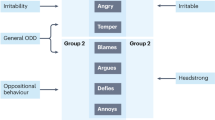Abstract
The outcome of children diagnosed with oppositional defiant disorder (ODD) has yet to be clearly established. Oppositional disorder (OD) first appeared in DSM III (1980), and then ODD replaced it in the DSM III-R (1987). At the time of this writing, there were no published articles in the literature on children followed into adulthood who were previously diagnosed with either OD or ODD. Might at least some children with ODD develop a personality disorder in the transition to adulthood? The entire cluster of ODD symptoms is not contained in a solitary personality disorder in the DSM IV-TR or International Classification of Diseases, 10th edition (ICD-10). A personality disorder from pre-DSM and pre-ICD personality nosology that had symptoms that met ODD diagnostic criteria was found. This personality disorder clearly appeared to be a more severe disorder than ODD. Ongoing misperceptions and an uncompromising, argumentative stance are the most prominent characteristics of this more severe disorder. Full DSM-style diagnostic criteria are proposed for it. These can be tested to determine this disorder’s validity. However, further research is needed.
Similar content being viewed by others
References and Recommended Reading
Erismann T: Der trotz. In Verstehen und Bilden. 1. Jahrgang, Heft 1-3. Heraus-geben von Bode und Fuchs. Halle, Germany; 1926.
Winkler H: Der Trotz, sein wesen und seine behandlung. Munich: Ernst Reinhardt Verlag; 1929.
Levy DM: Oppositional syndromes and oppositional behavior. In Psychopathology of Childhood. Edited by Hoch PH, Zubin J. New York: Grune & Stratton; 1955: 204–226.
Steiner H: Disruptive behavior disorders. In Kaplan & Sadock’s Comprehensive Textbook of Psychiatry, edn 7, vol 2. Edited by Sadock BJ, Sadock VA. Philadelphia: Lippincott Williams & Wilkins; 2000: 2693–2703.
American Psychiatric Association: Diagnostic and Statistical Manual of Mental Disorders III. Washington, DC: American Psychiatric Association; 1980.
American Psychiatric Association: Diagnostic and Statistical Manual of Mental Disorders III-R. Washington, DC: American Psychiatric Association; 1987.
Lahey BB, Loeber R, Stouthamer-Loeber M, et al.: Comparison of DSM III and DSM III-R diagnosis for prepubertal children: changes in prevalence and validity. J Am Acad Child Adolesc Psychiatry 1990, 29: 620–626.
Loney BR, Lima EN: Classification and assessment. In Conduct and Oppositional Defiant Disorders. Edited by Essau CA. Mahwah, NJ: Lawrence Erlbaum Associates; 2003: 3–31.
World Health Organization (WHO): International Classification of Diseases, edn 10. Geneva: WHO; 1992.
Kraepelin E: Lectures on Clinical Psychiatry. Revised and edited by Johnstone T. New York: William Wood & Company; 1904.
von Krafft-Ebing R: Textbook of Insanity. Translated by Chaddock CG. Philadelphia: F.A. Davis; 1905.
Birnbaum C: Uber Psychopathische Personlichkeiten. Wiesbaden, Germany: Verlag von J.F. Bergmann; 1909.
Kraepelin E: Manic-depressive Insanity and Paranoia. Translated by Barclay RM. Edinburgh, Scotland: E & S Livingstone; 1921.
Bleuler EP: Textbook of Psychiatry. Authorized English edition by Brill AA. London: MacMillan; 1924.
Kahn E: Psychopathic Personalities. Translated by Dunbar HF. New Haven, CT: Yale University Press; 1931.
Weygandt W: Lehrbuch der Nerven und Geisteskrankheiten. Halle, Germany: Carl Marhold Verlagsbuchhandlung; 1935.
Gruhle HW: Grundriss der Psychiatrie. Munich: Verlag von J.F. Bergmann; 1947.
Kretschmer E: A Textbook of Medical Psychology. Translated by Strauss EB. London: Hogarth Press; 1952.
Jaspers K: General Psychopathology, vols 1 & 2. Translated by Hoenig J, Hamilton MW. Chicago: University of Chicago Press; 1968.
Kolle K: Uber querulanten. Archiv fur Psychiatrie 1931, 95: 24–100.
Hitzig E: Ueber Quarulantenwahnsinn. Leipzig, Germany: Verlag von F.C.W. Vogel; 1895.
Dietrich H: Querulanten. Stuttgart, Germany: Ferdinand Enke Verlag; 1973.
von der Heydt A: Querulatorische Entwicklungen. Berlin: Marhold; 1952.
Astrup C: Querulent paranoia: a follow up. Neuropsychobiology 1984, 11: 149–154.
Goldstein RL: Litigious paranoids and the legal system: the role of the forensic psychiatrist. J Forensic Sci 1987, 32: 1009–1015.
Freckelton I: Querulent paranoia and the vexatious complainant. Int J Law Psychiatry 1988, 11: 127–143.
Rowlands MW: Psychiatric and legal aspects of persistent litigation. Br J Psychiatry 1988, 153: 317–323.
Ungvari GS, Hollokoi RI: Successful treatment of litigious paranoia with pimozide. Can J Psychiatry 1993, 38: 4–8.
Lester G, Wilson B, Griffin L, et al.: Unusually persistent complainants. Br J Psychiatry 2004, 184: 352–356.
Goldstein RL: Paranoids in the legal system. The litigious paranoid and the paranoid criminal. Psychiatr Clin North Am 1995, 18: 303–315.
Swanson DW, Bohnert PJ, Smith JA: The Paranoid. Boston: Little, Brown, and Co.; 1970.
Manschreck TC: Delusional disorder and shared psychotic disorder. In Kaplan and Sadock’s Comprehensive Textbook of Psychiatry, edn 7, vol 2. Edited by Sadock BJ, Sadock VA. Philadelphia: Lippincott Williams & Wilkins; 2000: 1243–1264.
Pelman C: Psychische Grenzzustande. Vierte Auflage. Bonn, Germany: Verlag Friedrich Cohen; 1920.
Kolle K: Psychiatrie. Stuttgart, Germany: Georg Thieme Verlag; 1961.
Huber G: Psychiatrie Lehrbuch fur Studium und Weiterbildung 7. Auflage. Stuttgart, Germany: Schattauer; 2005.
Bumke O: Lehrbuch der Geisteskrankheiten. 14. Auflage. Munich: Verlag von J.F. Bergmann; 1936.
Haymann H: Differentialdiagnostik in der Psychiatrie. Dresden, Germany: Verlag von Theodor Steinkoff; 1930.
Siemerling E: Querulantenwahnsinn. In Lehrbuch der Psychiatrie. 6. Auflage. Herausgebern von O. Binswanger und E. Siemerling. Jena, Germany: Verlag von Gustav Fischer; 1928.
American Psychiatric Association: Diagnostic and Statistical Manual of Mental Disorders IV-TR. Washington, DC: American Psychiatric Association; 2000.
Author information
Authors and Affiliations
Corresponding author
Rights and permissions
About this article
Cite this article
Tucker, S.G., Weller, R.A., Petersen, C.L. et al. Do some children diagnosed with oppositional defiant disorder develop querulous disorder?. Curr Psychiatry Rep 9, 99–105 (2007). https://doi.org/10.1007/s11920-007-0078-7
Published:
Issue Date:
DOI: https://doi.org/10.1007/s11920-007-0078-7




